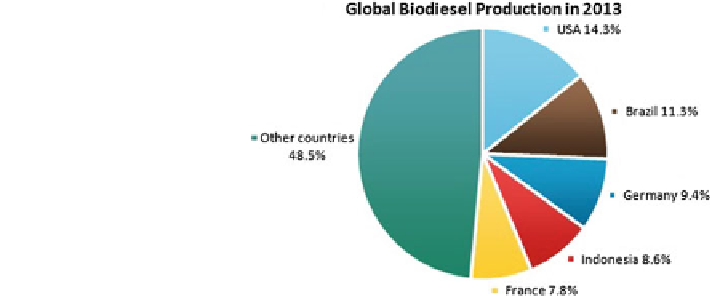Environmental Engineering Reference
In-Depth Information
Fig. 2 Different countries
involved in biodiesel
production
production, it is not being done commercially because the raw oil is too expensive and
after adding the cost of converting it to biodiesel, it becomes impossible to compete
with fossil diesel. Also in country like India, food crops can never be selected for
sustainable alternative bioenergy production where food security is a priority. In
India, Jatropa curcas seeds were proposed for biodiesel production due to its high oil
content, but the program was failed miserably due to unavailability of land for its
production. It was earlier projected that barren lands would be used for its cultivation
rather than agricultural fertile land, but it was a major failure.
Most of the industrial biodiesel is produced from waste vegetable oil sourced
from restaurant, industrial food producers, chip shops, etc. Waste vegetable oil can
be sourced for free which needs to be treated before conversion to biodiesel.
Biodiesel produced from waste vegetable oil can compete with cost of petroleum-
based diesel due to zero cost of the raw material.
During last decade, global biodiesel market has showed incredible growth.
Production as well as demand has increased almost sevenfold since 2005. Today,
the market still continues to grow mainly due to European Union countries. Brazil
and Argentina with USA are lagging slightly behind as their main focus is bio-
ethanol rather than biodiesel. In EU, Germany and France are leaders in regional
biodiesel output; other main producers include Poland, the Netherlands, and Italy.
EU is forecast to still dominate biodiesel market till the end of this decade; how-
ever, Latin American countries will also increase their shares in both biodiesel
production and consumption in the near future. (
http://mcgroup.co.uk/researches/
biodiesel
dated 06/21/2014). Figure
2
shows the contribution of different countries
worldwide toward biodiesel production in 2013.
2.3 Algal Biofuels
Algal biofuels have attained high signi
cance as a third-generation biofuel, due to
their fast growth potential along with high lipid, carbohydrate, and nutrient content.
Microalgae are known to produce and accumulate lipids in the form of

Search WWH ::

Custom Search